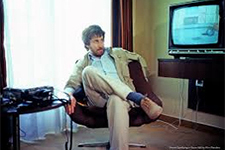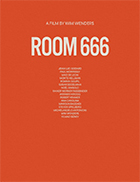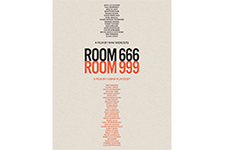Room 666 (Chambre 666)
|  By the end of the 1970s, Wim Wenders had become a major figure of the New German Cinema. His celebrated “road trilogy”—Alice in the Cities (Alice in den Städten, 1974), Wrong Move (Falsche Bewegung, 1975), and Kings of the Road (Im Lauf der Zeit, 1976)—had assured him a spot alongside the likes of Rainer Werner Fassbinder, Werner Herzog, and Volker Schlöndorff. Like other leading European filmmakers of the 1960s and ’70s, he was then lured to Hollywood, initially by Francis Ford Coppola, who produced his first English-language film, Hammett (1982). The production of that film was long and difficult, and at one point Wenders abandoned it entirely to work on what would become his first feature documentary, Lightning Over Water (aka Nick’s Film, 1980), which started as a collaboration with director Nicholas Ray, but turned into a documentary about Ray’s final days before succumbing to cancer. Wenders would spend the rest of his career alternating between fictional feature films and documentaries, many of which investigated the nature of cinema itself. Such is the case with Room 666 (Chambre 666), which is built around a deceptively simple set-up: During the 1982 Cannes Film Festival, Wenders, who was there with Hammett, invited an array of filmmakers who were screening films at the festival to sit in front of a static 16mm camera in room 666 of Cannes’s Hotel Martinez and respond to the following prompt about the future of the cinema: “More and more films look they’ve been made for television in terms of lighting, framing, and pacing. It seems that for the greater part of the world, television aesthetics have completely replaced movie aesthetics. A great number of films refer to other movies instead of referring to any reality outside itself. Fewer movies are made. The cinema, is it a language about to get lost, an art about to die?” Television, a technology that had been around for more than three decades at that point, but was taking on more and more cultural prominence, especially in the era of made-for-television movies and the rapidly expanding home video market, was heavy on Wenders’s mind, which is why he had his interview subjects prominently flanked by a television on their left, its screen alight with whatever happened to be broadcasting at that moment while they spoke. Wenders does not appear in the film except as a stand-in for Turkish director Yilmaz Güney, who could not attend because he was in political hiding, but sent his written responses (he was supposed to be there to represent the film Yol, for which he wrote the screenplay and which took home that year’s Palm d’Or). Otherwise, there is no one in the room for each interview other than the subject him- or herself, which turns each sequence into a uniquely personal and direct conversation with the viewer. The range of filmmakers Wenders was able to get in front of his camera is impressive, as they represent a broad cross-section of international art film, Hollywood, and cult cinema: Michelangelo Antonioni (Italy), Maroun Bagdadi (Lebanon), Ana Carolina (Brazil), Mike De Leon (Philippines), Rainer Werner Fassbinder (West Germany), Jean-Luc Godard (France), Romain Goupil (France), Yilmaz Güney (Turkey), Monte Hellman (U.S.), Werner Herzog (West Germany), Robert Kramer (U.S.), Paul Morrissey (U.S.), Susan Seidelman (U.S.), Noël Simsolo (France), and Steven Spielberg (U.S.). Although Wenders provided each person with the same question, each subject responds in a completely different way. Godard, who is the first on-screen, gives the lengthiest response, reading the entirety of Wenders’s prompt and then going off a uniquely Godardian riff on cinema while constantly looking back at a French Open tennis match on the TV screen next to him. Some are long, some are short. Some look at the future with great optimism (Antonioni, in particular, seems excited about the relationship between humanity and technology), while others see only loss and dread (Morrissey dourly declares that every artform is now dead). Spielberg, who had recently hit both highs (1981’s Raiders of the Lost Ark) and lows (1979’s 1941), talks primarily about the difficulties of working within the Hollywood industry, and Herzog removes his shoes, declaring that such questions must be answered barefoot, before going off on a tangent that, with shocking accuracy, predicts how the Internet would come to be the center of even the most banal aspects of commerce (buying groceries). As a time capsule, Room 666 is utterly essential, providing a unique and telling window into the thinking of major international filmmakers during a period of profound technological, industrial, and ideological transition. As a piece of pure cinema, it is disarming in its simplicity, so stripped of artifice or editorializing that we sometimes see the subjects walk up to the camera to turn it off. It is like sixteen miniature films on cinema, each one utterly unique and yet also inextricably intertwined.
Copyright © 2025 James Kendrick Thoughts? E-mail James Kendrick All images copyright © Janus Contemporaries | |||||||||||||||||||||||||||||
Overall Rating: 

 (3)
(3)


 This Blu-ray release includes both Room 666 (1982) and Room 999 (2023).
This Blu-ray release includes both Room 666 (1982) and Room 999 (2023).